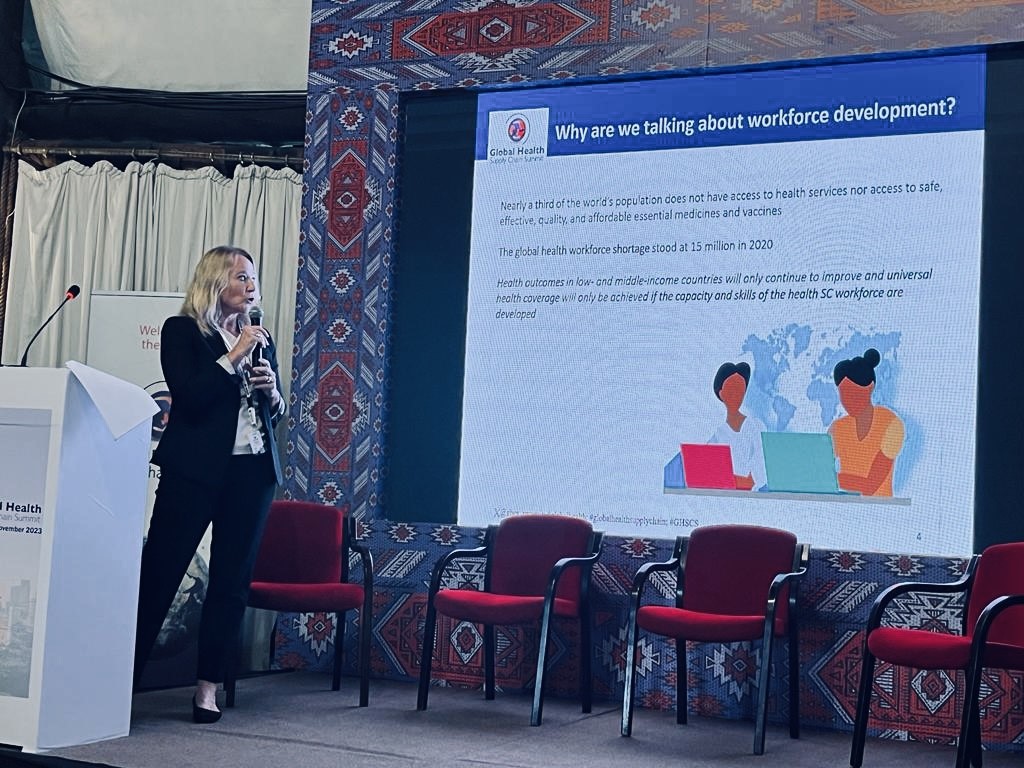On day one of the Global Health Supply Chain Summit in Nairobi, the People that Deliver (PtD) coalition made the case for investing in supply chain workforce development.
PtD’s Dominique Zwinkels and Jonathan Moody were joined by Bridget McHenry from USAID and Stanley Chindove from the Global Fund to Fight AIDS, Tuberculosis and Malaria to present the Business case for investment in human resources for health supply chain management.
Opening the presentation, Dominique pointed out that the global health workforce deficit stood at 15 million in 2020 and although this situation is improving, progress is slow in Africa.
“Health outcomes in low- and middle-income countries will only continue to improve and universal health coverage will only be achieved if the capacity and skills of the health SC workforce are developed,” she said.
Skills: The focus of investments but still lacking
As part of the business case, PtD collected data on the country-level budgeted investments for human resources for supply chain management (HR for SCM) from three donor organisations – Gavi, the Vaccine Alliance, the Global Fund and USAID – over the period 2017-2020. This data was accompanied by a survey and interviews with supply chain managers in countries.
Data was aggregated by donor organisation, year and pathway, among other parameters. PtD’s Human resources for supply chain management Theory of Change (ToC) posits that four pathways – staffing, skills, motivation and working conditions – must be addressed if the health supply workforce is to perform optimally and access to health commodities is to increase according to PtD’s foundational framework.
The data show that staffing and skills are the pathways that receive the bulk of the investment allocations, with most investments dedicated to skills, while motivation and working conditions receive negligible allocations. Despite this focus on skills, the survey responses and deep-dive interviews demonstrated that there is a perceived lack of skills among health supply chain professionals in country.
Investing in all four pathways in Malawi and Ethiopia
Two case studies – in Malawi and Ethiopia – exemplify the value of investing in all four pathways.
The introduction of trained pharmacy assistants (PAs) into pharmacies in Malawi in 2018 led to improvements related to skills, staffing, motivation and working conditions. The addition of the PAs saved clinicians six days per month on average, allowing them to spend more time with patients, and led to a spill over effect of knowledge and skills within their own facilities. It also led to improved retention and according to survey responses the introduction of the PAs helped to boost motivation.
Crucially, stockouts improved at facilities that had introduced PAs.
The implementation of the ToC in Ethiopia also provides evidence to support investments in all of the four pathways. Following interventions across the four areas, tangible supply chain improvements were seen, including a 25 percent decrease in procurement lead time, a 35 percent decrease in contract signing lead time and a 5.5 percent decrease in tender lead time.
Recommendations
Appealing to the audience at the conference, Bridget called for an increase in investments in HR for SCM as a whole, in particular in the often-overlooked motivation and working conditions pathways.
She also highlighted to need to monitor investments in the four pathways. The business case research revealed a lack of data on the impact of investments in HR for SCM; this causes myriad problems. First, it is impossible to document with certainty how investments are having a positive impact on supply chain performance. What’s more, without impact assessments in each pathway (staffing, skills, motivation and working conditions) the exact necessary budget allocations in each area cannot be determined.
Bridget therefore recommended that mechanisms be developed and implemented to monitor and evaluate the impact of investments in the four pathways. Without such monitoring, it will not be possible to determine the isolated impact of investments in HR4SCM the return on investments in the four pathways.
Read PtD’s Business case for investment in human resources for health supply chain management.

